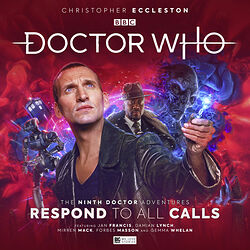
 |  |  |

 | Reviews for The Ninth Doctor Adventures: Respond to All Calls |
|
 |  |  |
There is 1 review so far. To add a review of your own for this item, visit the voting page.
| By: | David Layton, Los Angeles, United States |
|
| Date: | Monday 31 October 2022 |
|
| Rating: |    8 8 |
The second set of adventures with Christopher Eccleston returning as The Doctor takes us firmly toward the Doctor 9 we saw on television. This second box set featuring three stories of Doctor 9, recorded under difficult lockdown circumstances, takes us back season 1 of Nuwho in style and tone. The stories themselves are all set before The Doctor meets Rose. This is a Doctor on his own. Unlike the mood set with Doctor 10, that The Doctor on his own would run out of control, we see here a Doctor "on call," saving lives on a case by case basis. The stories are all very personal, local emergencies involving historical nobodies, the ordinary people finding it hard just to get by. Yes, in two of the stories the Universe seems to be at risk, but these are more metaphorical dilemmas than actual dilemmas, large-scale interpretations of the difficulties people often have when their personal universes are falling apart. Eccleston is clearly having fun as The Doctor, reminding us just how energetic and enthusiastic his Doctor was. To get the Russell T. Davies vibe, Big Finish went to new, younger writers for these scripts, and used a Present - Past - Future pattern for the stories. The first story is "Girl, Deconstructed." This is the story of the Present, early 2000s. Teenagers are going missing in Scotland and it has something to do with the Doctor's efforts to track down what has gone wrong with the Serafim (I'm not sure of the spelling). The story is a sci-fi, haunted house depiction of teen angst, centering on Marnie, a teen girl struggling to connect with her single father, wishing simply that she could be anywhere other than home. Having a teen girl be both absent and present is a great metaphor for what teens often go through. Some of the explanations of events are a bit dodgy, and The Doctor is a bit too precise in his TARDIS control, a convenience to make the plot run smoothly that is out of sync with Doctor Who lore. The second story, the Past story, called Fright Motif, takes us to Paris, around 1949, recovering from the war. An American musician working in a hotel finds he can no longer play music. He's being pursued by an other-dimensional sound monster, as well. While the first story symbolized teen angst and family disconnection, this one symbolizes grief. In trying to save the situation, The Doctor brings together three very different people all dealing with grief in different ways. The sound monster is the symbol of that grief, destructive, drawn to the sounds that remind people of what they have lost. For me, this is the weakest of the three stories. There is quite a bit of running around to no end, and the resolution seems stretched out. Last is the Future story, Planet of the End, by playwright Timothy X. Atack. This one, in my opinion, is by far the best of the three. That is, in part, because Atack has more cleverly hidden the personal problem that is the real center of the story. The Doctor has responded to a distress signal that takes him to the far future when most intelligent races have come and gone. The planet is a giant cemetary-memorial to these lost races, but one on which no one is actually allowed to visit or memorialize anyone lest their presence "disturbs" the memorials. Apart from wildlife, the only intelligent presence on the planet is an AI robot, managed from afar by an officious oaf. The signal The Doctor has followed is a lure for a trap, so that The Incorporation, ancient beings from the dawn of the Universe, can resurrect themselves and begin again their business operations of destruction for profit. Atack does not even try to hide his contempt for modern corporate greed, or his disdain for corporate executives. This would seem to be the focus of the story, but in fact the actual focus of the story is the robot AI, whom The Doctor names Fred. The AI is symbol of the ordinary employee, whom the executive class "employ" in the sense of use. Allowed no identity outside of function, expected to follow directives without question, no matter how foolish those directives are, and not allowed to display will or personality, Fred is in some sense every-employee. By treating the AI as a person, giving it a name, talking to it as an equal, asking for its help rather than ordering it, The Doctor helps Fred to liberate itself, to realize its own desires, and to resolve its crisis of being. Thus, what appears to be a big, universe-threatening, all-hands-on-deck Doctor Who story, is, at heart, about The Doctor helping one person toward self-realization, an identity separate from the job. The set is enjoyable, especially given Eccleston's mix of fun, enthusiasm, and seriousness. The set makes one realize how much audiences missed by having Eccleston for only one season on TV.


